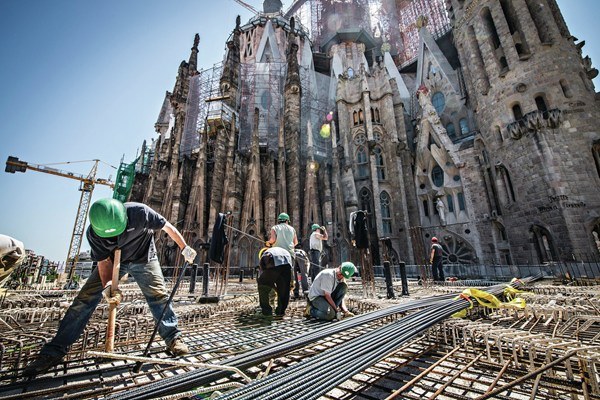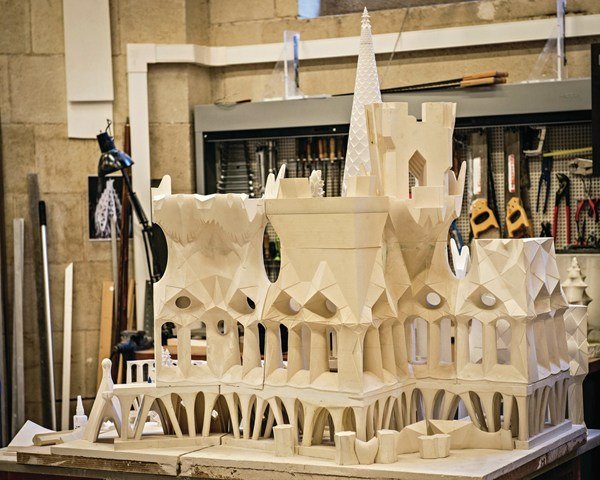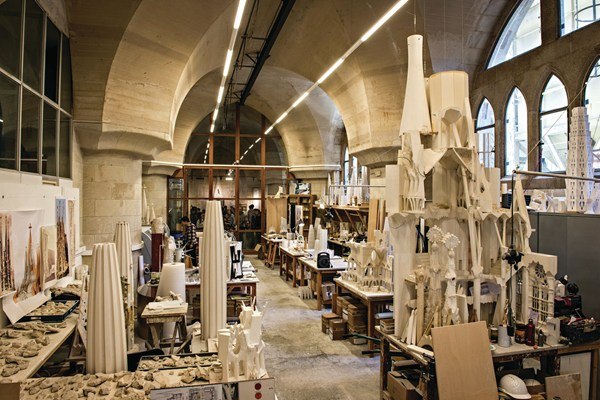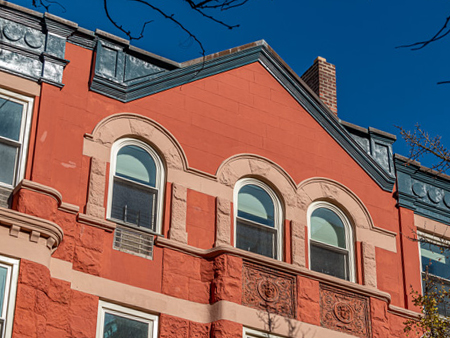Ian Volner reports for Architect magazine.
With newfound modeling capabilities and insight into Antoni Gaudí’s vision, the chief architect of the Basílica de la Sagrada Família aims to complete the long-stalled project by 2026.
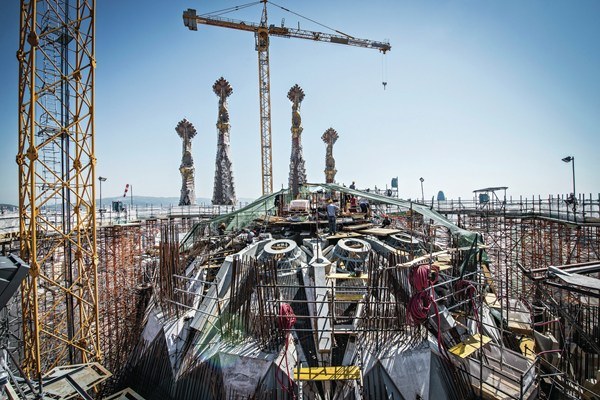
As construction deadlines go, 130 years certainly seems like a generous allowance. But in cathedral years, that’s almost a drop in the bucket. After all, Germany’s Cologne Cathedral broke ground in 1248 and wrapped up centuries later in 1880. The still-rising Cathedral Church of Saint John the Divine in Manhattan is already 121 years old, with no completion date in sight.
Other structures, such as England’s Coventry Cathedral, were generations in the making, only to be destroyed by war, fire, or structural failure and then repaired or built anew. From the nave to the transept to the last finial of the westwork, creating a church fit for a bishop entails a long-term commitment. The fact, then, that the Basílica i Temple Expiatori de la Sagrada Família in Barcelona, Spain, first got underway 13 decades ago would be almost unremarkable but for the particular character of the basilica itself, and of the man who designed it.
The massive church—technically not a cathedral by Catholic law, the official seat or cathedra of the bishop being the nearby Catedral de la Santa Creu—is unlike any other house of worship in the world with its well-known, spiky, fanciful, mud-castle-like ensemble of swirling towers and twisting columns. Its architect, Catalan-born Antoni Gaudí, was among the giants of European architecture and a major transitional figure at the moment when 19th-century Beaux-Arts historicism was giving way to 20th-century Modernism. Sagrada Família is the fullest expression of his highly idiosyncratic vision.
Since its construction was first halted in 1936 amidst the tumult of the Spanish Civil War, the basilica’s state of incompletion has become part and parcel of its very identity: The cranes, rubble, and half-finished sculptural friezes around the site seem like permanent fixtures of the streetscape.
Funding holdups, strikes, and problems deciphering Gaudí’s intentions have led to endless delays since construction resumed in 1939. Many have simply come to assume it will never be done. Toni García, a Barcelona native and culture writer for Spanish newspaper El País, joked that the state of affairs has entered the local patois: “When you want to say, ‘Oh, that’ll never happen,’ you say, ‘Sure—it’ll happen when Sagrada Família is finished.’ ”
Workers reinforce the project site to accommodate the anticipated construction of new structures, such as the Glory façade at the project’s south entrance, as well as towering additions to the existing structure.
But now it seems that the proverbial pigs may be taking flight. In 2012, Barcelona-born architect Jordi Faulí assumed control of the project. The Construction Board of the Sagrada Família Foundation, the organization in charge of fundraising and advocacy for the project, could hardly have picked a more qualified candidate. Along with completing a doctoral thesis on the church’s design, Faulí has spent more than 20 years as a junior architect on the team overseeing the church’s construction.
Shortly after his appointment as the chief architect of Sagrada Família, Faulí surprised everyone by declaring that the project would be finished far sooner than previously thought. “We anticipate finishing the six central towers around 2020, and completing the overall architectural form of the project around 2026, a hundred years after Gaudí’s death,” he said, adding this not-insignificant caveat: “provided circumstances allow us to follow the current rhythm.”
However long it may last, Faulí and the project team, which has comprised as many as 300 workers, stonemasons, sculptors, bricklayers, and designers, have managed to achieve this accelerated pace by establishing a firmer idea of what the building should really be, and what tools they should use to make it possible.
Realizing the geometric complexity of Gaudí’s vision for Sagrada Família has been helped by the advent of 3D printing and modeling technology. Ultra-precise resin mock-ups made by consultants, such as 3D Systems, have assisted in guiding decisions about the project’s design and structural behavior.
Last fall, the Construction Board of the Sagrada Família Foundation released a new video showing a time-lapse projection of how construction will unfold over the next 13 years. The 76-second clip uses aerial photography and sophisticated digital imaging to show how new spires will spring up around the perimeter, how the masonry cladding will wrap around them, and how the pointed tympana will fill out the façade.
The central dome will be topped by an enormous, apparently openwork, tower, completing the symbolic conceit that had been at the heart of Gaudí’s scheme: 18 individual spires to represent the prime dramatis personae of the New Testament, 12 for the apostles, four for the evangelists, one for the Holy Virgin, and another for Christ himself in the middle. The video is the definitive vision of the future church, the culmination of years of archival research—including the discovery of a trove of Gaudí documents in the Historic Archives of the City of Barcelona several years ago—to determine Gaudí’s intentions and to help the foundation make tough decisions about what could and couldn’t be done. “
We commissioned the video when we had almost completed the investigation of the remaining parts of Gaudí’s design,” Faulí says. “For the first time, we had sufficient material to produce a virtual model.” The video also signals the vast technological leaps that have changed every aspect of the project, Faulí says. “This model couldn’t be produced before, primarily for technical reasons—advances in computer power, precise 3D scanning of the existing building, and 3D prototyping allowed us to work at a scale and a level of detail hitherto impossible to achieve.”
Being able to model the building better goes hand in hand with completing it faster: the decorative details that once had to be hewn by skilled artisans are now done by fast-moving CNC (computer numeric control) cutters working from digital patterns; structural problems that would have daunted previous builders can now be solved with the click of a mouse.
An assortment of study models of the church and its components made over time by architects, modelmakers, and designers fill the model room in the basement of Sagrada Família.
Even more subjective design unknowns are now under the sway of the new computer-driven approach. Graham Lindsay, European sales director for advanced printing manufacturer and services provider 3D Systems, headquartered in Rock Hill, S.C., has been helping to develop prototype models of specific ornamental and structural units for Sagrada Família for several years. “One of the things that will happen is that we’ll print off a part in three or four different styles,” he says. “Then before they build that section, we’ll send the model to a group of well-known, renowned architects who can give some insight into what Gaudí would have thought, and they’ll discuss which part Gaudí might actually take.”
The process helps assuage the concern of those who worry the current band of builders is departing from the conception of their illustrious predecessor. Such concerns do linger, however, and the project remains a contentious one. In particular, there is the tricky question of whether a building so long incomplete even should be finished, or whether Faulí and his collaborators are at risk of turning a beautiful semi-ruin into a half-baked mock-up of Gaudí’s ideal. Or worse: They could fail again to finish on schedule, leaving a mock-up that is still only partially complete. But Faulí, noting the mostly positive reaction of new visitors to the construction site, remains convinced that the final product will live up to expectations.
Confidently, the architect is already looking ahead to what will follow after the 2026 deadline. “Although we aim to complete the structure in 13 years,” he says, “there will remain a host of tasks for the many artists and sculptors completing the symbolic narrative that Gaudí set out to provide.” Then, perhaps to hedge his bets, Faulí keenly muses: “Are the great cathedrals and basilicas of the world ever truly finished?”

